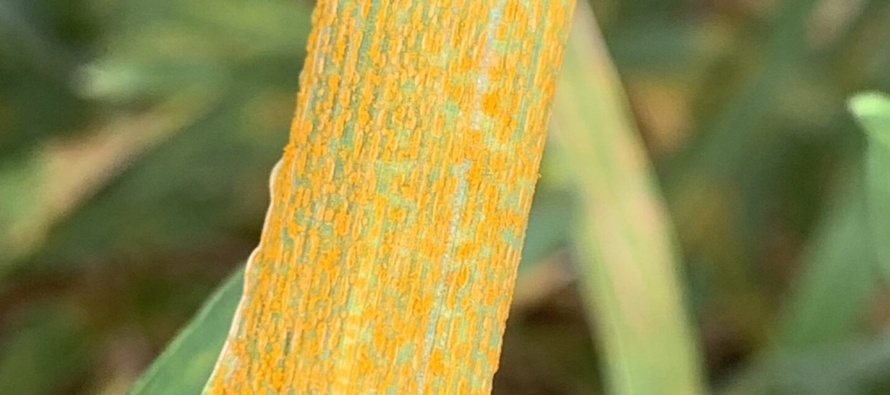Wheat Disease Update: April 13, 2024

Related Articles
- Rice Variety Trial Results For 2010, Plus Rice Research Report 0
- Evaluation of Peanut Prescription Rx Program in Mississippi 0
- 2010 Row Crop Short Course Video Links 0
Latest Tweets
In general, the wheat crop this season looks to be in good shape, despite a wetter than normal month. However, now is generally the time of the year when most foliar disease issues begin to be observed. More wheat is generally scouted once the flag leaf emerges and the head starts to come out of the boot. With that in mind, there are a few “important” diseases that can be observed this time of the year. Some can be more problematic than others, and some should be paid attention to. However, knowing the variety planted in a field is an important step in determining whether a fungicide application is necessary. Also, staying abreast of the specific risks associated with diseases such as Fusarium head blight is also important. More on that specific disease below. Be mindful that one of the most important first steps prior to deciding on a management strategy is to properly identify and confirm the disease in the field. Oftentimes there are multiple diseases that will look similar to one another so knowing the key differences between some of those specific diseases is important. I have outlined some of what I would consider to be the more “common” disease issues that oftentimes occur during this time of the wheat season.

Stripe rust of wheat will produce “stripe” lesions on the leaf that tend to have pustules producing spores.
Stripe rust
So far, a few observations of stripe rust have been made in Mississippi. Two weeks ago, the first observation of stripe rust was made in Stoneville, in the variety trial. Since that time, I’ve received at least one additional observation from Benton County, in far northern Mississippi. Most of the time, the wheat varieties planted in our production system tend to fall between tolerant and resistant to stripe rust. However, there are likely some susceptible varieties planted in localized areas. Determining the variety is the most important step and then basing decisions from that point forward. Not every field will require a fungicide application and paying careful attention to pre-harvest intervals on labels is important. Should a fungicide be deemed necessary to manage stripe rust, considering looking at the fungicide efficacy data for wheat which is available through the Crop Protection Network and can be accessed at: https://cropprotectionnetwork.s3.amazonaws.com/cpn3002_fungicideefficacywheatdisease2023-1684787198.pdf.
Diagnostically, keeping stripe rust straight from diseases such as bacterial leaf streak (see photo at the left above) is also important. Stripe rust will almost always produce pustules and the spores will burst through the leaf tissue and produce the “typical” stripe on the leaf. Bacterial leaf streak generally occurs following cool and wet weather, produces a similar “striping” pattern, but will not only not have the typical spore masses, but will generally make an indentation in the leaf itself. Use a hand lense if you’re questioning yourself and make sure you see spores. If you don’t see spores, then it is more likely bacterial leaf streak and fungicide application will not be beneficial.
Septoria tritici blotch (or Septoria leaf blotch)
A fairly common foliar disease in the lower to middle canopy. Look for lesions with mostly jagged edges, a yellow halo around the outside of the lesion and the pepper grains (pycnidia) embedded within the leaf tissue. In wet years there can oftentimes be a good bit of Seprotia tritici blotch in the lower canopy. However, more often than not this particular disease is not a yield-limiter and in general does not move above two leaves below the flag leaf. Monitor for the presence of the disease and be aware that it may occur anywhere in Mississippi. However, I would suggest that there is likely resistance presence within wheat varieties that would keep this disease in the lower canopy and reduce the likelihood of it causing yield losses.
Fusarium head blight (or scab)
The best place to consider the potential “risk” underlying whether or not a scab epidemic may start this year would be at https://www.wheatscab.psu.edu. A substantial amount of weather data and several years of computer modeling have been put into developing this particular predictive model tool. At present, and even considering the potential risk six days into the future (so, approximately April 19, 2024) it appears that the risk of scab in Mississippi would be low. Keep abreast of the information as it changes over time by returning to the tool. The most conducive weather for the development of scab is when moisture in the form of rainfall occurs at the time of flowering. Fungicides have been proven effective at reducing the losses that can be associated with scab, such as the toxin associated with the disease (don toxin) as well as reducing the potential test weight losses that can occur. For information related to the best fungicides available for managing scab refer to the link above (or https://cropprotectionnetwork.s3.amazonaws.com/cpn3002_fungicideefficacywheatdisease2023-1684787198.pdf). Fungicides are listed in the column under “head scab”.






Let me tell You a sad story ! There are no comments yet, but You can be first one to comment this article.
Write a comment